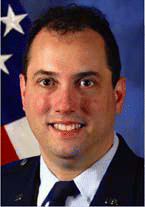Major Charles J. Fox, MD, of Walter Reed Army Medical Center, a vascular surgeon who works closely with otolaryngologists, has studied combat-related neck trauma in American soldiers. He noted that the preponderance of cervical injuries caused by blasts, 79%—compared with 21% by high-velocity gunshot—means that few wounds are likely to be “clean.” Of course the first priority is to stabilize the airway and/or hemorrhaging, but it is crucial to explore for occult damage caused by blast fragments, and the sooner scans and arteriograms can be done, the better, Dr. Fox said.
Explore This Issue
May 2007Triage and Screening
It is important for the right people to do the right screening. In the Cole bombing, initial triage showed nine of 39 patients with head and neck injuries. But when otolaryngologists conducted the screening, they found that 23 of the patients had those injuries.
Dr. Golz is another advocate of early exploration. He finds that once injuries are ruled out, some fragments can be left alone, avoiding further trauma.
After an attack most hearing loss is temporary and most perforated eardrums will heal spontaneously, but emotional distress should not be ignored, said Dr. Golz. His unit received the victims of the rocket attacks on northern Israel, as well as evacuated soldiers from Lebanon, in last summer’s war. “All of the injured, especially children, need TLC,” he said.
Otolaryngologists in combat remind us that this is not your father’s war or your father’s otolaryngology. The “meatball” surgery of Korean War-era MASH units is long gone. Even the first Gulf war was very different from the current one. Dr. Holt, who served in both, recalls that in the first Gulf war, troops were prepared for chemical and biological attack, but faced a conventional army. “In this one we’ve been learning on the fly. It’s urban, guerrilla warfare. There’s nothing clean or gentlemanly about it,” he observed.
Access to Treatment
In war, as in peacetime medicine, treatments have improved dramatically, but it is now their access that has become a major challenge. The Marines deploy Forward Resuscitative Surgery System teams, with a median time to treatment of one hour. Thanks to Dr. Brennan, special head-and-neck teams now include an otolaryngologist, as well as a neurosurgeon, an ophthalmologist, and an oral surgeon. Delivered by the famed Critical Care Aeromedical Transport (CCAT) jets—essentially, flying ICUs—a team can reach any soldier in Iraq within 45 minutes. (The US military uses a “buddy system” for the services, pairing the Navy with the Marines and the Army with the Air Force.) Quick access to subspecialists, Dr. Brennan emphasizes, has helped send the percentage of surviving wounded from 70 to 75% in Vietnam, to more than 90% in Iraq.


Leave a Reply